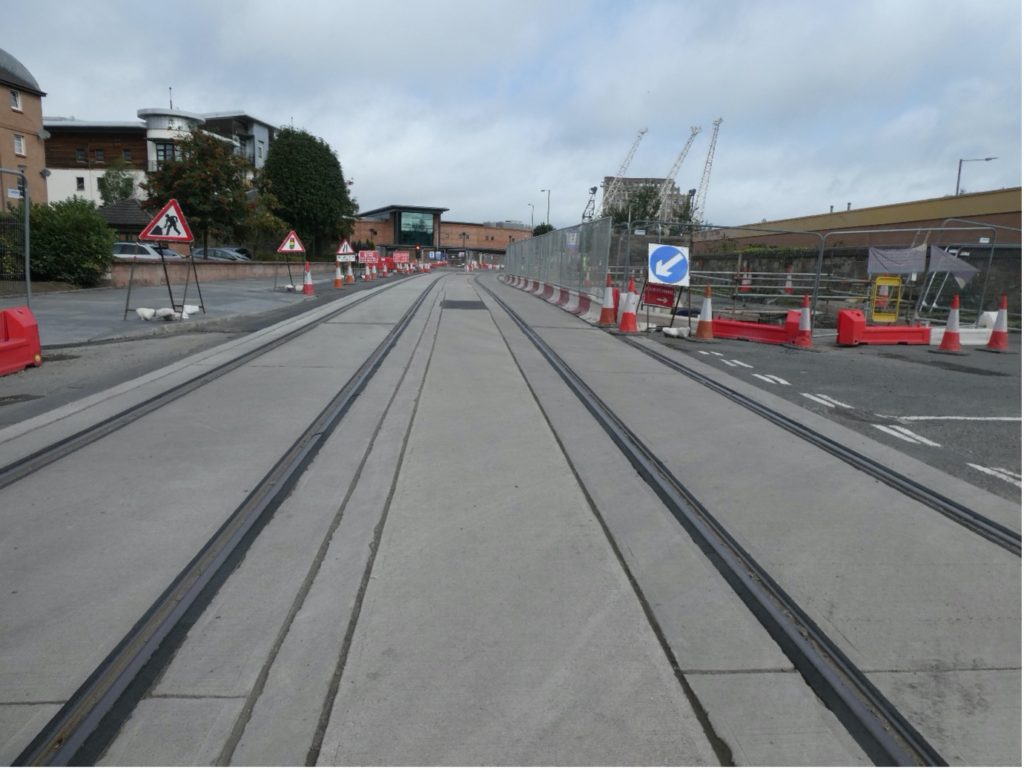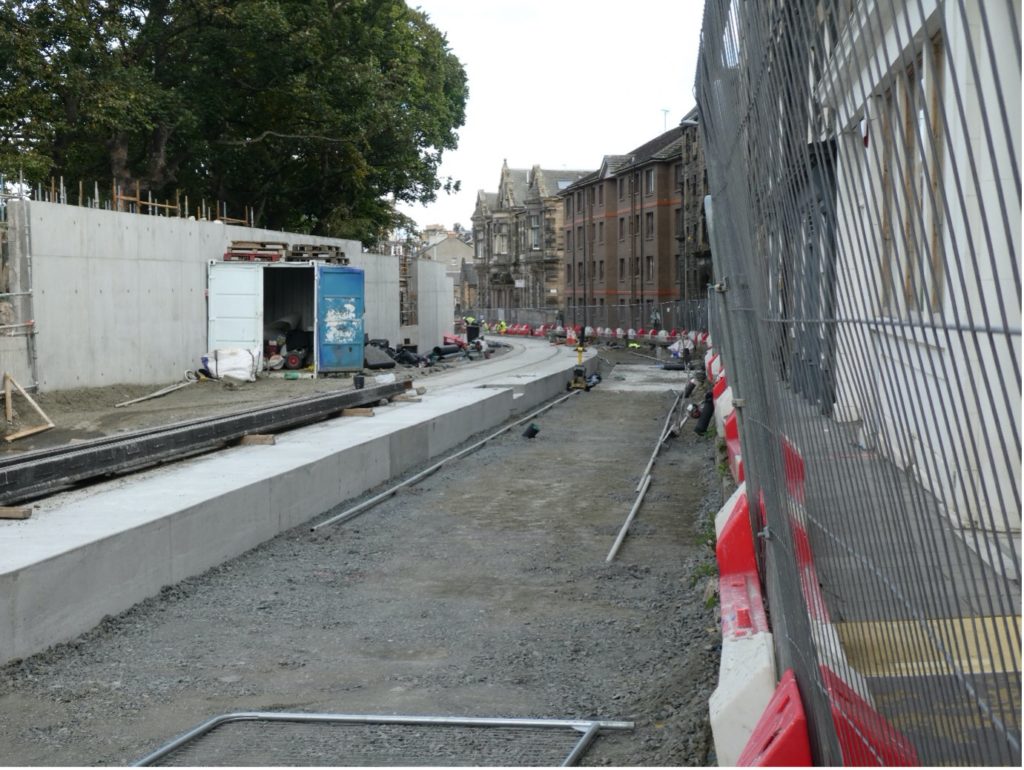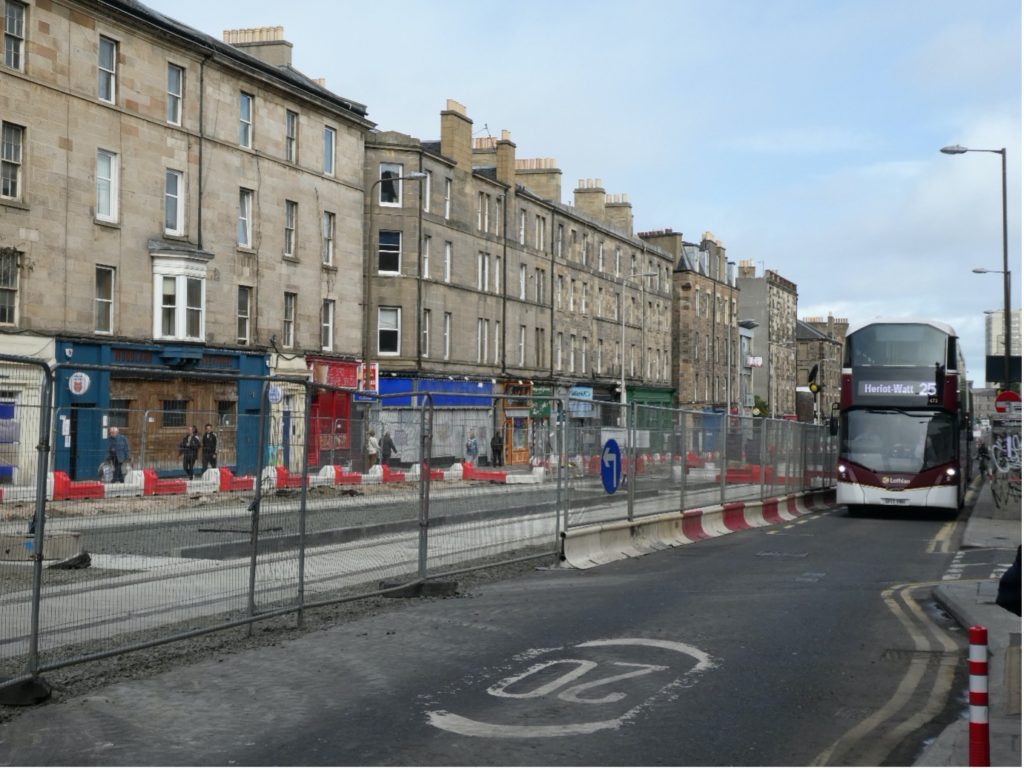Gradually, people are starting to meet face to face again, and my September visit to the Light Rail Summit in Edinburgh was a welcome relief after 18 months of Teams, Zoom and the repeated phrase: “You’re on mute!” The event was hosted by Edinburgh Trams, UKTram and the Light Rail Safety and Standards Board (LRSSB) and nearly 100 delegates, mainly representing the UK’s light rail networks, attended to hear about UKTram’s and LRSSB’s work over the last two years.
The event included a presentation and walking tour around the works to extend the Edinburgh Tram system to Newhaven and, whilst the text of this article concentrates on other summit matters, the illustrations highlight progress on the extension as a visual update to David Shirres’ article in issue 188 (Jan-Feb 2021).

George Lowder, CEO of Transport for Edinburgh and Chair of UKTram, opened the event and delivered a roundup of progress made during the pandemic, especially the productive relationship established with the Department for Transport (DfT) and Treasury. He was also pleased to report that the pandemic had enabled the development of much better governance for UKTram and LRSSB, leading to the publication of a handbook describing roles and responsibilities, amongst other things.
UKTram
James Hamnett, Managing Director of UKTram, presented the draft Light Rail Strategy that is currently out for consultation with members and stakeholders including the DfT. The strategy argues the benefits and contribution of light rail to the economy and people’s lives, stating that light rail will contribute to ‘building back better, greener and faster’ and will invest in urban areas to continue to drive their economies, though this will not all be focused on London and the Southeast.
Amongst other things, the strategy aims to focus on UK employment and R&D with regard to vehicle & infrastructure construction, signalling, power and control systems, services (operations, cleaning etc.). It promises to support high street outlets as well as retail centres, be a catalyst for regional improvements in economic and social mobility, and significantly improve regional air quality and landscapes.
The strategy also states that light rail can be an important contributor to the ‘Restore your Railways’ programme; support central government investment projects, e.g., HS2 connectivity; help provide world class schools and hospitals with world class local transport networks; and help develop UK expertise that can be exported across the world.
There was a great deal of positive comment from the delegates and, said James: “The strategy, which was widely welcomed by summit delegates, builds a compelling case for future investment in light rail and looks at ways to remove barriers to the expansion of existing systems and the building of new networks. Crucially, it highlights the many economic, environmental and social benefits of putting tramways and similar transit systems at the heart of future integrated urban transport networks.” He added that UKTram plans to publish the strategy by the end of the 2021/22 fiscal year.

Global comparisons
Alistair Gordon, CEO of Keolis UK, presented some international comparisons. Keolis UK are involved in light rail operations in Manchester, Nottingham, and London Docklands. Internationally, Keolis is a €6 billion company operating in 16 countries with over 68,000 employees. It serves 3.4 billion passengers and 300 transport authorities, according to 2020 figures. It operates more than 10 transport modes and has over 23,000 buses, of which more than 4,000 are non-diesel.
Alastair said that, compared with mainland Europe, the UK has not invested in light rail. He said that since 2000, 108 European cities have built light rail systems, with 20 of them in France. He added that of 72 European cities/metropolitan areas with populations of more than one million, only three do not have light rail systems and they are all in the UK.
Alistair’s view was that this difference is explained by the strategic framework in France where: (i) the public transport vision includes a long-term plan with integrated public transport, aimed at reducing the reliance on the car; (ii) there is a single authority to drive schemes with the power to tax locally and invest in transport; and (iii) the business case framework includes features which value drivers for economic growth and where not all costs are passed onto the developer. This creates a sustainable market providing certainty for the supply chain to invest, with an emphasis on investment in local technology. There is currently nothing like this in the UK except, possibly, in London.
The benefits
Jonathan Bray, Director of Urban Transport Group, provided examples of light rail’s benefits. In Tyne and Wear, 67% of customers do not have access to a car, Jonathan said, adding that light rail is not just about transport links from A to B, but also enables change. The example given was the comparatively small sum of £20 million spent on the Manchester Metrolink extension to Salford Quays which enabled inwards investment in Media City worth well over £500m.
He said that light rail has some of the highest levels of public transport customer satisfaction and that surveys often indicate that people would not give up their car for a bus but would do so for light rail. In terms of the green agenda, more electric cars will not deliver as they still emit pollution from tyres and brakes. Light rail is already green but could become even more so – for example by finding ways of harvesting 100% of their braking energy.
Jonathan stressed the importance of building an “armoury” of evidence to support the argument for light rail. He said this needed to be presented as part of a national debate on how our cities can be made better, rather than being considered as a local issue as it often is now. He called for a fast-track approval process for schemes which, in turn, should be developed using template scheme designs, and a much more collaborative approach to multi-modal public transport such as one would find in London and countries such as Switzerland.
Innovation: FOCUS+
Next was a presentation about an innovation aimed at improving safety by Neil Clark, CEO of Integrated Human Factors. UKTram had formulated the Driver Innovation Safety Challenge (DISC). With trams largely operated by driving on sight, and with little or no immediate response in the event the driver passes a stop signal or misses some other significant hazard, it is vital that an appropriate level of care is provided to ensure driver wellbeing and prevent error prone states – for example, fatigue. Neil noted that only 10% of all rail and road accidents are the consequence of equipment failure.
The product developed through DISC is called FOCUS+. It is a fatigue, health and wellbeing monitoring system consisting of a wrist wearable device and hub. The hub can be attached to a belt or secured within the vehicle cab. The system passively collects the driver’s biometric data which is anonymised and stored within a secure Amazon Web Services environment. The data is processed using machine learning models developed for each individual user. Red, amber, and green alerts are generated to signal the wellbeing of the wearer. A red alert, for example, means that the wearer’s biometric data has significantly deviated from its normal baseline and Neil emphasised the importance of learning what normal looks like for each wearer.

The medical measurements include heart rate, oxygenation, and skin temperature, and in their normal states these vary between individuals. What is normal for some people might be a red alert for others. The device also transmits time, GPS position, and acceleration/gyro data.
Volunteers required
Working with UKTram, IHF has been seeking volunteers to test the system. They will receive full training on the system and will have the opportunity to provide feedback on the system over a period of six months. The testers will be asked to wear the systems routinely and will also be asked to provide a range of demographic and health data, including height, weight, sex and age, to help the designers develop the data baselines.
The discussion was mainly about whether drivers and unions would support the system. Acceptance will possibly depend on how well management and unions are already cooperating on a ‘just culture’ where individuals are not blamed for honest errors but are held accountable for wilful violations and gross negligence. People are generally less willing to inform the organisation about their own errors and other safety problems or hazards if they are afraid of being punished or prosecuted.
Protect+
Another innovation, this time about an improved Authority to Work (ATW) process called Permit+ was sponsored by UKTram and is being trialled in Edinburgh. Anthony Stevenson, Managing Director, Codemakers described the system which is to be marketed and operated by a spin-off company, Metrotech. Currently many ATW systems are paper based where applicants (typically public and utilities) and responders are only connected by the paper or email trail. Permit+ aims to provide a transparent cloud, web, and app-based system available to the applicants and run by the tramway.
The applicants are provided with a secure system for making applications with a case management process for both the applicant and the tram operator. Hazard identification and risk mitigation are integral to the process and when the permit is issued, all the conditions are part of the permit which can be carried on a mobile app, allowing people carrying out the work and the operator’s inspectors to verify easily that conditions are being complied with and agreed mitigations have been applied. In circumstances where there is a charge for access, the system includes an integral mechanism for charging and is able to accept card payments or to invoice known organisations. This can include different prices for various application types and can accommodate surcharges if applied.
The LRSSB

Carl Williams, Chief Executive of the Light Rail Safety and Standards Board (LRSSB) updated the meeting on progress since the organisation was established as part of the sector’s response to a Rail Accident Investigation Branch report into the tragic 2016 Croydon derailment. Now in its second year, LRSSB has cemented its position in the sector’s consciousness and with stakeholders. An early piece of work was the development, with Atkins, of an industry risk model that provides the sector with individual network and national risk profiles, ensuring more control of emerging risks and precursors to incidents. In 2020/21, Carl added, the output of the tool indicated a reduction in the national Total Fatality Risk to passengers of 12%, and a 4% reduction in the National Total Risk profile to passengers, public and staff.
New standards have been published as well as a number of guidance notes, reports and good practice guides, some of which are intended to assist in closing out recommendations in the RAIB investigation report into the Sandilands accident.
He said that projects in progress included one to fully integrate the Tram Accident and Incident Recording system (TAIR) into the risk model, and a project to fully populate a digital reference library to be hosted on the LRSSB website.
Looking forward, Carl reminded the meeting that there is currently no obligation on operators to be a Member of LRSSB or to comply with its output, unlike the situation on the main line network where operators are required to be Members of RSSB and to comply with Group Standards. As LRSSB was set up with only an initial three-year funding agreement, the requirement of membership would provide LRSSB with stable funding and, with the Office of Rail and Road (ORR), he is discussing making membership of LRSSB a licence condition for operators.
Pooling knowledge
Working groups, a key part of UKTram’s remit, are responsible for pooling knowledge as well as identifying and commissioning work. Their membership comes mainly from the operators, together with a UKTram staff member who takes forward their work programmes. Each group gave a report.
UKTram’s Mark Davis, General Manager, Croydon and Steve Duckering, UKTram Operations Manager, reported from the Executive Group. Current activity includes working to understand each operator’s contract models to develop and guide on good practice. An example future project aims to make recommendations about rolling stock procurement which could include, perhaps, joint procurement.
Matt Taylor described the Centre of Excellence, a group of about 20 tram experts, with collaboration from Network Rail. The group advises anyone on issues likely to be faced when promoting, gaining approval, or extending light rail schemes. When an issue is identified, the appropriate experts meet in smaller groups to offer advice. They are not solely cheerleaders for light rail and will not offer it as a solution if it is clearly inappropriate.
The group has developed a route map to help promoters cover all the activities needed to get to a Transport and Works Act order, and they are now working on a new template to help people thinking about a light rail system to decide whether light rail is the right solution. Finally, they are working with current Independent Competent Persons to increase the supply to alleviate a shortage of people qualified to perform this role.
Further developments
Mark Ashmore, Safety and Assurance Manager at LRSSB reported on the Health and Safety Group’s work. This includes work to integrate TAIR into the risk model; development of a new dashboard to help users better understand what the risk model is indicating; using bow tie modelling (BowtieXP software) to help operators develop suitable controls for identified risks; and the use of RM3 audit tools with peer review to assess the maturity of operators’ safety management systems.
Iain Middlemass, Head of Tramway, Blackpool and Craig O’Brien, Engineering Manager, both at UKTram, gave the Engineering Group’s report. Space is insufficient to report fully on all their work as it covers several activities in each of over a dozen broad categories. A notable example was an initiative to assess all operators’ rail grinding needs with the aim of encouraging a grinding supplier to base a suitable machine in the UK that can be called on by all networks as required. They have a programme to create standards or guidance and 12 topic areas were described, from stray current management and engineering techniques, to managing the risk of trapping and dragging people caught in tram doors.

They are also seeking an externally moderated benchmarking arrangement similar to those currently facilitated by Imperial College London (e.g., CoMET and NOVA). They also had a long list of R&D topics including pedestrian distraction at level crossings; detection of cars at level crossings; standardisation of fire-fighting systems for rail vehicles; improving the safety performance of passenger rail vehicle glazing systems; integrated information management systems, improving the effectiveness of rescue operations at railway accidents; and the development of a derailment detector.
Sharing solutions
The final working group report came from Mike Mabey, Head of Operations, Nottingham and a second outing for Steve Duckering. Over the last 18 months the Operations Group’s focus has been keeping staff and customers safe during Covid. Sharing experiences and solutions was doubly important during this period to share what worked and what didn’t when knowledge was still emerging. The current topics for the working group included getting customers number back to the pre-Covid levels; mental health issues amongst staff leading to absence issues; and recruitment, linked to the HGV driver shortage.
The working group is also considering the challenges of sourcing replacement buses during engineering work due to unavailability of bus drivers; the sharing of best practice on driver training to help fill the recruitment issue where drivers might resign with one month’s notice; and the development of a common definition for signals passed at stop.
Conclusion
It is pleasing to see how much work is being done to draw the sector further together in order to improve both safety and efficiency, and to promote the development of the sector as a green solution for public transport in urban/suburban transit.
Thanks to UKTram’s Jamie Swift for his assistance with this article. See video on their strategy at https://tinyurl.com/4p8t8km6.

